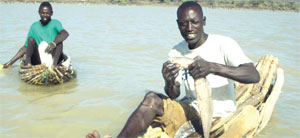By HAROLD AYODO
He left for a fishing expedition at 6am, but caught only two fish after three hours in Lake Baringo on a Saturday.
Reuben Sang says fishing, which has been his family’s main source of livelihood for the past two decades, is no longer a lucrative activity.
"Lake Baringo was a gold mine but of late we can go fishing for five hours and return to the shore with empty nets," Sang says.
The seasoned fishermen says he could get ten fish and sell to nearby lodges and walk home with at least Sh1, 500 daily. |
William Cherotich and Reuben Sang on a fishing expedition in Lake Baringo. Fish stocks have been diminishing in the lake in the recent past. [PHOTO: HAROLD AYODO/STANDARD] |
"It is unbelievable that nowadays I can walk home with less than Sh300 following the ‘drought’ in the lake," Sang says.
Today, prices of catfish that were once abundant have shot to Sh300 up from about Sh150 less than a year ago. Tilapia was another edible species whose stocks have been diminishing over the past two decades.
Another fisherman, William Cherotich, says the situation in the lake is so dire that it sometimes takes up to six hours a day to net only three cat fishs.
"We are wondering what would happen in the coming months as the situation seems to be going from bad to worse," Cherotich says.
He says the dwindling stocks have led to a mass exodus of their colleagues – especially from the Luo community – to seek greener pastures elsewhere.
Huge catches
"We learnt a lot from Luo fishermen who have a long history of the trade … they would cast their nets late in the night and return with huge catches at dawn," Cherotich says.
The situation has further been compounded by the fact that the area cannot support farming due to unreliable rain patterns leaving the riparian communities – Njemps, Turkana, Pokot and Turgen – at a crossroads.
Even the Kampi ya Samaki Township, a once thriving fishing village on the shores of the lake, is now a pale shadow of its former self.
A recent report by the Kenya Marine and Fisheries Research Institute (KMFRI), shows the Lake Baringo fish stocks have been declining since 1988.
The report documents how fish species that were found in the lake have been vanishing over the years.
According to the report, KMFRI senior deputy director Enock Wakwabi says the lake was once a vibrant fishing ground, with a wide range of species.
Unsustainable exploitation
The fresh water lake also supported a processing plant and a large fish market, which are now extinct.
At some point, managers of fisheries introduced closed seasons when fishing was stopped to give the lake time to regenerate, but that did little to restore fish stocks.
However, experts point out that the diminishing stocks have nothing to do with unsustainable exploitation and habitat degradation.
According to the study by KMFRI, the 1.2 million livestock kept by pastoralist communities is partly to blame for the crisis.
They argue large herds destroy plant and cause gullies, which make it easy for soil to be washed into the river during rains. As a result, there is heavy deposition of silt into the lake leading to sedimentation.
This is estimated to be taking place at a rate of 206 metric tonnes per hectare per year.
It is estimated that a record 10.38 million metric tonnes of are deposited in the lake annually.
Scientifically, siltation not only reduces the depth and surface area of the lake, but also affects the aquatic habitat. This ultimately affects productivity.
Dry weather
Dr Wakwabi says the highly valued tilapia species in Lake Baringo was the most affected because it nests in deep water.
Furthermore, the erosion also washes fluoride fragments into the lake, which over time has exceeded levels recommended by the World Health Organisation.
As the stocks of fish in the fresh water lake continue to dwindle, visitors — foreign and domestic tourists — now mainly use it for boat rides.
The experts also say the occasional dry weather and drying up of the rivers that drain it into lake are the other factors that have affected its water levels.
The main rivers that empty into the lake are Molo and Ol Arabel, both of which flow from the Mau highlands. Lake Baringo Research Expedition project co-ordinator Jones Muli says that Molo River dries up before reaching the lake.
On going rapid destruction of indigenous forests in the lake basin are also concerns as the area has lost more than half of its natural forest cover.
 The Standard Group Plc is a multi-media organization with investments in media
platforms spanning newspaper print operations, television, radio broadcasting,
digital and online services. The Standard Group is recognized as a leading
multi-media house in Kenya with a key influence in matters of national and
international interest.
The Standard Group Plc is a multi-media organization with investments in media
platforms spanning newspaper print operations, television, radio broadcasting,
digital and online services. The Standard Group is recognized as a leading
multi-media house in Kenya with a key influence in matters of national and
international interest.
 The Standard Group Plc is a multi-media organization with investments in media
platforms spanning newspaper print operations, television, radio broadcasting,
digital and online services. The Standard Group is recognized as a leading
multi-media house in Kenya with a key influence in matters of national and
international interest.
The Standard Group Plc is a multi-media organization with investments in media
platforms spanning newspaper print operations, television, radio broadcasting,
digital and online services. The Standard Group is recognized as a leading
multi-media house in Kenya with a key influence in matters of national and
international interest.










